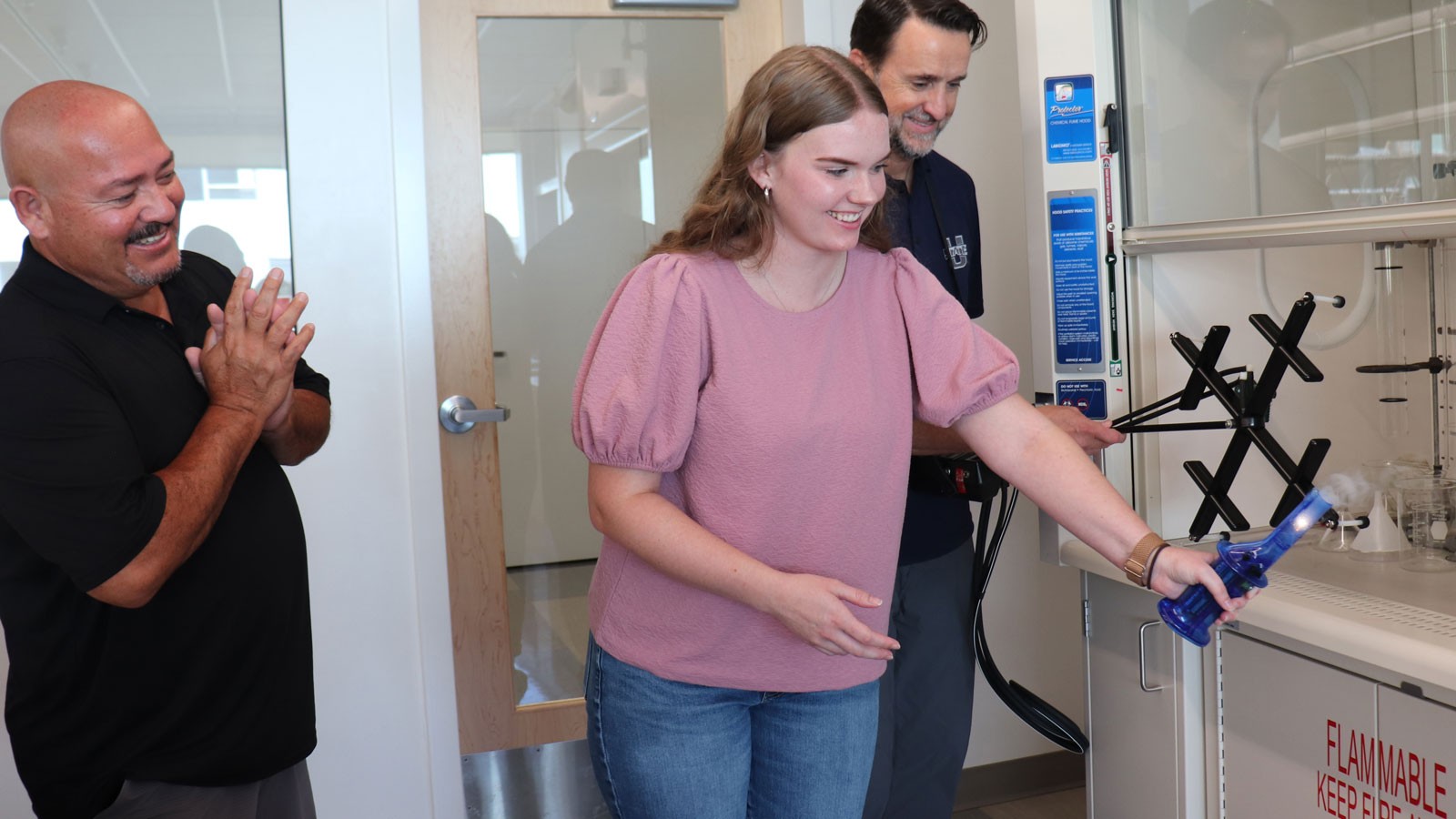A Healthier 'Big Picture': USU Industrial Hygiene Undergrad Explores Community Wellness
Janna Cook applies occupational health and safety principles during Texas Instruments internship.
By Mary-Ann Muffoletto |
In USU's Industrial Hygiene lab, student Janna Cook, center, with instructors John Flores, left, and Carl Farley, right, practices use of a fog generator for airflow visualization testing of a ventilation hood. (Photo Credit: USU/M. Muffoletto)
Des Moines, Iowa native Janna Cook has always had an interest in health and medicine, along with the sociological factors that affect a person’s wellbeing. But that’s not the first thing that propelled her to Utah State for undergraduate study.
“I fell in love with Logan while serving a mission here for The Church of Jesus Christ of Latter-day Saints,” says Cook, who began her studies at Utah State in August 2022, after receiving a USU academic merit admissions scholarship.
“I love the Logan community,” she says. “It’s small enough to feel like a small town, yet it has large-town resources. Overall, people here look out for each other.”
Majoring in public health appealed to Cook, who had already gained impressive community health experience at the local and international levels through participation in nonprofit organizations in Iowa, Arizona and the Dominican Republic.
“In my future career, I hope to create healthier, more resilient communities,” she says.
Industrial hygiene was not on her radar until she arrived at Utah State.
“I hadn’t even heard of it, but after talking with adviser Carl Farley in the Department of Biology, I decided to pursue it,” says Cook, who added a minor in Hunger and Food Security Studies, offered by USU’s Department of Nutrition, Dietetics and Food Sciences.
It might seem an unusual combination, but not to Cook.
“In Industrial Hygiene, we’re focused on occupational health and safety, which is a big part of most people’s daily lives,” she says. “The U.S. Bureau of Labor Statistics reports Americans between the ages of 25-54 spend an average of 40.2 hour per week at work.”
Pairing on-the-job health with a person’s food security encompasses the wellbeing of that individual, as well as the wellbeing of their family, and the health of a community.
“We tend of think of these things separately, but they all fit together,” Cook says.
While pursuing rigorous coursework in physical, chemical and biological hazards, along with mathematics, biology and chemistry, the undergrad scholar also serves as co-director of USU’s Student Nutrition Access Center, known as SNAC, which provides food assistance to Utah State students.
“People tend to think of food insecurity as something that affects just unhoused people or ‘poor’ people, but SNAC reports some 33 percent of students on USU’s Logan campus are considered food insecure,” Cook says. “There have been days when I’ve seen long lines of students seeking assistance at SNAC.”
This past summer, Cook traveled to the Dallas, Texas area to fulfill an internship requirement with semiconductor manufacturer Texas Instruments. Among her assignments were ergonomics risk assessments, which included observing employees performing varied tasks, such as use of lifting devices and other tools, along with developing project and survey plans.
“It was interesting to apply what I’d learned in class and in the lab to real-life practice,” Cook says. “It was challenging and I enjoyed the problem-solving aspect of the work. The experience definitely solidified my decision to pursue an industrial hygiene career.”
Internships, says John Flores, coordinator and course instructor of USU’s Industrial Hygiene internship program, are among the most important components of IH students’ undergrad experience, because they give students the opportunity to apply concepts and practices learned in the classroom to a real-world workplace. This past summer, Flores, principal lecturer in the Department of Biology, helped coordinate placement of 22 USU industrial hygiene majors in 18 companies and organizations throughout the nation.
“Internships also allow students to determine if a specific industry is a good fit for them,” he says. “We tell students internships are like a three-month interview, which can often turn into a full-time job offer after graduation.”
Flores notes graduates of USU’s IH program, which is one of only four Accreditation Board for Engineering and Technology (ABET)-accredited undergraduate industrial hygiene degree programs in the nation, have nearly 100 percent job placement upon completion of their degrees.
“We encourage our students to pursue as many as three to four internships during their undergraduate career, to gain as much workplace experience as possible,” he says. “We can only do this because we’ve built relationships with employers who are willing to provide internships for our students, knowing those students have yet to complete required courses. Having on-the-job experience makes the classroom experience much more meaningful.”
Cook, who just completed her sophomore year at USU says, even though she’s just starting industrial hygiene-specific courses, she felt USU prepared her well to have a meaningful internship experience.
“Our USU instructors, John Flores, Carl Farley and Scott Bernhardt, are very thorough and really take the time to talk through workplace scenarios, demonstrate use of tools and equipment and take us on field visits to local industries,” she says.
Cook’s glowing evaluation from Texas Instruments confirmed her capabilities, praising her ability to quickly understand her project goals and execute a professional-level plan that included completing nine ergonomic office assessments, assisting with three safety incident investigations and assisting with an asbestos review.
Cook will use what she learned at Texas Instruments to create her capstone project and says the experience helped her understand the “bigger picture” of occupational health and safety.
“One of the overriding goals of industrial hygiene is to prevent risks before they happen,” she says. “It’s a system-wide, evidence-based process that requires thorough examination of workplace hazards and development of plans and procedures to mitigate those hazards.”
WRITER
Mary-Ann Muffoletto
Public Relations Specialist
College of Science
435-797-3517
maryann.muffoletto@usu.edu
CONTACT
John Flores
Principal Lecturer
Department of Biology
435-797-8194
john.flores@usu.edu
TOPICS
STEM 164stories Internship 47storiesComments and questions regarding this article may be directed to the contact person listed on this page.







